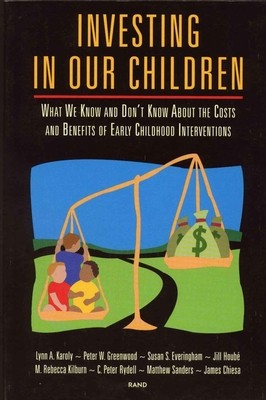
- We will send in 10–14 business days.
- Author: Lynn A Karoly
- Publisher: RAND Corporation
- ISBN-10: 0833025309
- ISBN-13: 9780833025302
- Format: 15.4 x 22.8 x 1 cm, minkšti viršeliai
- Language: English
- SAVE -10% with code: EXTRA
Reviews
Description
In Investing in Our Children: What We Know and Don't Know About the Costs and Benefits of Early Childhood Interventions, the authors find that well-targeted early intervention programs for at-risk children, such as nurse home visits to first-time mothers and high-quality preschool education, can yield substantial advantages to participants in terms of emotional and cognitive development, education, economic well-being, and health. This unbiased study details the benefits and savings generated by documented intervention programs and finds that, if the successes of these programs can be duplicated on a large scale, public investment in such programs will benefit not only the children and their families, but also the taxpayers who fund them. As more children reach their full potential as active contributors to the economy, the government will see long-term savings in the form of lower welfare payments, higher tax revenues, and lower criminal justice system costs. The authors, however, highlight that these conclusions rest primarily on smaller-scale model programs and call for broader demonstrations and rigorous evaluations of future large-scale programs.
EXTRA 10 % discount with code: EXTRA
The promotion ends in 21d.11:29:35
The discount code is valid when purchasing from 10 €. Discounts do not stack.
- Author: Lynn A Karoly
- Publisher: RAND Corporation
- ISBN-10: 0833025309
- ISBN-13: 9780833025302
- Format: 15.4 x 22.8 x 1 cm, minkšti viršeliai
- Language: English English
In Investing in Our Children: What We Know and Don't Know About the Costs and Benefits of Early Childhood Interventions, the authors find that well-targeted early intervention programs for at-risk children, such as nurse home visits to first-time mothers and high-quality preschool education, can yield substantial advantages to participants in terms of emotional and cognitive development, education, economic well-being, and health. This unbiased study details the benefits and savings generated by documented intervention programs and finds that, if the successes of these programs can be duplicated on a large scale, public investment in such programs will benefit not only the children and their families, but also the taxpayers who fund them. As more children reach their full potential as active contributors to the economy, the government will see long-term savings in the form of lower welfare payments, higher tax revenues, and lower criminal justice system costs. The authors, however, highlight that these conclusions rest primarily on smaller-scale model programs and call for broader demonstrations and rigorous evaluations of future large-scale programs.


Reviews